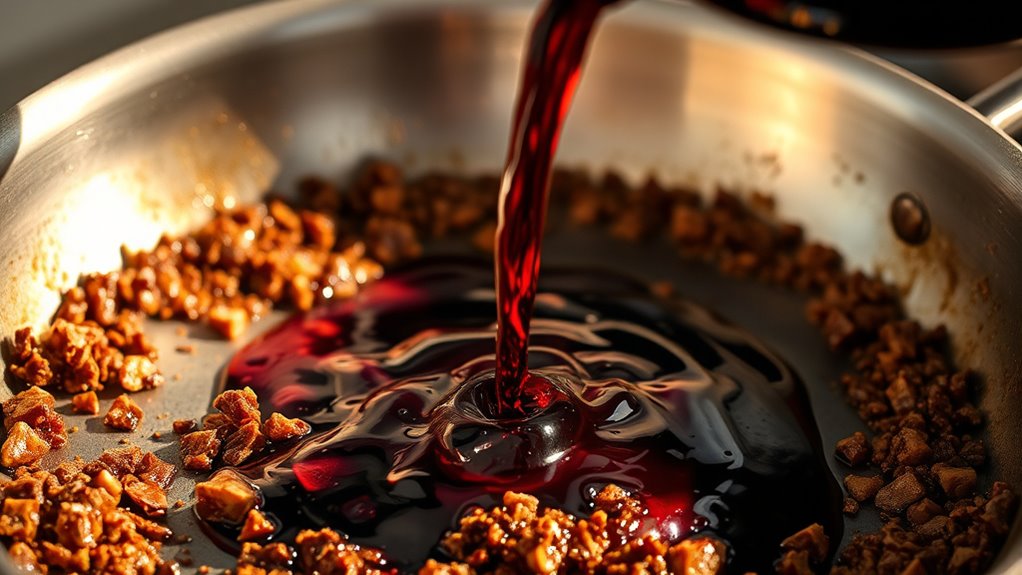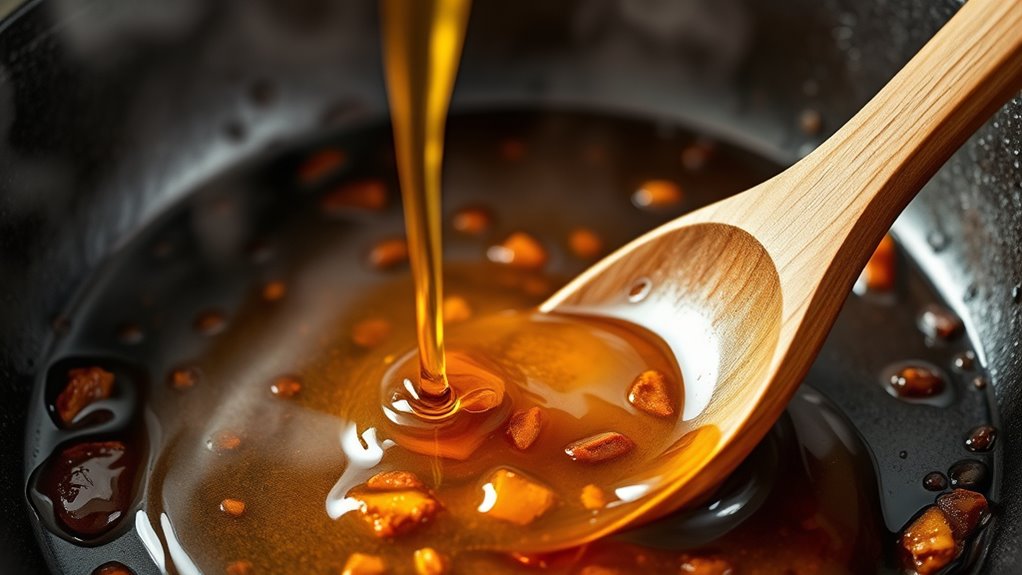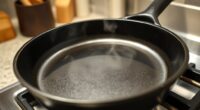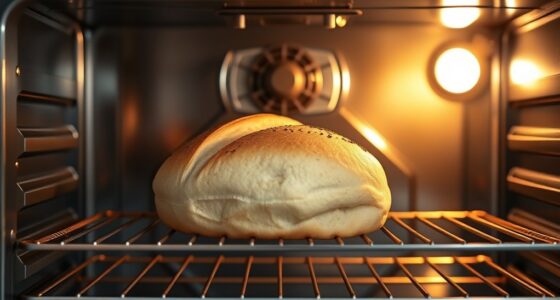To deglaze like a chef, first cook your protein and remove it from the pan, noticing the browned bits stuck to the bottom. Pour a small amount of liquid such as wine, broth, or water into the hot pan, then use a wooden spoon or spatula to scrape up those flavorful bits, lifting their rich taste into the liquid. Let it simmer and reduce to concentrate flavors, adding extras like butter or herbs as desired. Keep practicing, and you’ll master creating luscious pan sauces effortlessly.
Key Takeaways
- Remove cooked protein and keep pan hot to release flavorful browned bits (fond).
- Pour a suitable liquid (wine, broth, water) into the hot pan to loosen the bits.
- Use a wooden spoon or spatula to scrape and lift the browned bits into the liquid.
- Simmer the deglazing liquid to reduce, concentrate flavors, and create a base for sauce.
- Taste, adjust seasonings, and serve the flavorful sauce over your dish for enhanced richness.

If you’ve ever wanted to elevate your cooking, mastering the art of deglazing is a must. This technique transforms simple pan drippings into rich, flavorful pan sauces that can turn an ordinary dish into a culinary masterpiece. When you deglaze a pan, you’re fundamentally unlocking the flavor extraction process, capturing all those browned bits stuck to the bottom. These bits, known as fond, are packed with concentrated flavors that, when incorporated into a sauce, add depth and complexity to your dish. Understanding this process is key to making your meals taste restaurant-worthy.
To start, cook your protein—whether it’s chicken, beef, or fish—and once it’s done, remove it from the pan. While the pan is still hot, you’ll notice the browned bits clinging to the bottom. These are your flavor goldmine. Instead of discarding them, pour in a liquid such as wine, broth, or even water. As you do this, you’ll want to scrape the pan with a wooden spoon or spatula, gently loosening those flavorful bits. This action, called deglazing, releases the fond into the liquid, creating a base for your pan sauce.
After cooking your protein, deglaze the hot pan with liquid and scrape up the browned bits for rich flavor.
The key to effective flavor extraction is to let the liquid simmer and reduce. As it cooks, it thickens slightly and intensifies in flavor, absorbing all those savory notes from the browned bits. Keep stirring to incorporate everything evenly. If you want a richer sauce, you can add a splash of cream, a pat of butter, or a splash of vinegar at this stage. These additions not only enhance flavor but also give your sauce a silky texture. Remember, the goal is to concentrate those flavors, so don’t rush the reduction process; patience pays off here.
Once your sauce has thickened to your liking, taste it and adjust with salt, pepper, or herbs. Pour it over your cooked protein or vegetables for a burst of flavor. Using pan sauces made through deglazing is a straightforward way to add layers of taste without extra effort. Every time you cook and deglaze, you harness the full potential of the ingredients in your pan, making every dish more delicious. With practice, you’ll find that this simple technique can elevate your everyday cooking, turning simple ingredients into complex, mouthwatering flavors that make your meals truly stand out.
Frequently Asked Questions
Can Deglazing Be Done With Cold Liquids?
You can deglaze with cold liquids, but it’s not ideal. Cold liquid’s temperature slows flavor extraction from the browned bits in the pan, which can result in less flavorful sauce. For better results, use warm or hot liquids to quickly loosen those flavorful bits and maximize taste. Cold liquids may cause splattering and make it harder to scrape up the fond, so always aim for a warmer temperature to achieve the best deglazing.
What’s the Best Type of Pan for Deglazing?
You’ll want a pan with good heat distribution, like stainless steel or cast iron, for deglazing. These materials help distribute heat evenly, preventing hot spots and ensuring your fond releases smoothly. Avoid thin, lightweight pans that can heat unevenly. A wide, shallow pan also allows more surface area, making it easier to loosen and lift the flavorful bits stuck to the bottom. This results in a richer, more flavorful sauce.
How Do I Prevent Burning When Deglazing?
To prevent burning when deglazing, keep your cooking temperature low to moderate—think gentle, not fiery. Choose a pan with good heat distribution, like stainless steel or cast iron, to avoid hotspots that cause burning. Stir constantly and add liquid gradually. Remember, patience is your best friend; rushing with high heat will only turn your sauce into a smoky mess. Stay calm, stay cool, and enjoy the process!
Can Deglazing Be Used for Sweet Dishes?
Yes, you can use deglazing in sweet dishes. Instead of wine or broth, use sweet liquids like fruit juice, honey, or syrup for flavor enhancement. Be mindful of sugar reduction to avoid overly sweet results. Deglazing helps dissolve caramelized sugars and bits, adding depth and richness to desserts like caramel sauces or fruit compotes. Just keep the heat moderate to prevent burning and preserve the delicate flavors.
How Long Should I Deglaze Before Adding Other Ingredients?
Research shows that deglazing typically takes about 30 seconds to 1 minute. You should do it when the pan is hot enough to produce steam and sizzle, but not so hot that the liquid evaporates instantly. Add enough liquid to loosen the browned bits, usually a few tablespoons to a cup, then swirl the pan gently. Keep deglazing until the liquid reduces slightly, allowing flavors to meld before adding your other ingredients.
Conclusion
Now that you know how to deglaze like a chef, you can transform simple pan drippings into rich, flavorful sauces that elevate any dish. Remember, a little patience and attention to detail go a long way—after all, “A journey of a thousand miles begins with a single step.” Keep practicing, and soon you’ll turn everyday ingredients into culinary masterpieces. Happy cooking!









